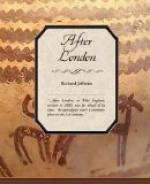WILD ANIMALS
When the ancients departed, great numbers of their cattle perished. It was not so much the want of food as the inability to endure exposure that caused their death; a few winters are related to have so reduced them that they died by hundreds, many mangled by dogs. The hardiest that remained became perfectly wild, and the wood cattle are now more difficult to approach than deer.
There are two kinds, the white and the black. The white (sometimes dun) are believed to be the survivors of the domestic roan-and-white, for the cattle in our enclosures at the present day are of that colour. The black are smaller, and are doubtless little changed from their state in the olden times, except that they are wild. These latter are timid, unless accompanied by a calf, and are rarely known to turn upon their pursuers. But the white are fierce at all times; they will not, indeed, attack man, but will scarcely run from him, and it is not always safe to cross their haunts.
The bulls are savage beyond measure at certain seasons of the year. If they see men at a distance, they retire; if they come unexpectedly face to face, they attack. This characteristic enables those who travel through districts known to be haunted by white cattle to provide against an encounter, for, by occasionally blowing a horn, the herd that may be in the vicinity is dispersed. There are not often more than twenty in a herd. The hides of the dun are highly prized, both for their intrinsic value, and as proofs of skill and courage, so much so that you shall hardly buy a skin for all the money you may offer; and the horns are likewise trophies. The white or dun bull is the monarch of our forests.
Four kinds of wild pigs are found. The most numerous, or at least the most often seen, as it lies about our enclosures, is the common thorn-hog. It is the largest of the wild pigs, long-bodied and flat-sided, in colour much the hue of the mud in which it wallows. To the agriculturist it is the greatest pest, destroying or damaging all kinds of crops, and routing up the gardens. It is with difficulty kept out by palisading, for if there be a weak place in the wooden framework, the strong snout of the animal is sure to undermine and work a passage through.
As there are always so many of these pigs round about inhabited places and cultivated fields, constant care is required, for they instantly discover an opening. From their habit of haunting the thickets and bush which come up to the verge of the enclosures, they have obtained the name of thorn-hogs. Some reach an immense size, and they are very prolific, so that it is impossible to destroy them. The boars are fierce at a particular season, but never attack unless provoked to do so. But when driven to bay they are the most dangerous of the boars, on account of their vast size and weight. They are of a sluggish disposition, and will not rise from their lairs unless forced to do so.




